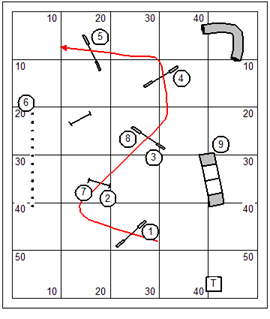The typical handling in agility is a phenomenon I call “connect the dots”. The handler runs his dog from obstacle to obstacle and does his best to solve the implicit riddle of the dog’s predictable path. Americans do everything the hard way, and we’re good at it.

You’ll note in this sequence that the dog has a good look at the dummy jump beyond jump #2. The handler will probably avail himself to a dog-on-left lead-out into a Front Cross to solve the transition and avoid the wrong course option. After jump #3 the dog will get a look at the pipe tunnel in the corner. But it’s a long way away and the handler should be able to easily draw his dog on Post to put a finish to the sequence.

What I’m going to ask my students to do, somewhat gratuitously is shape the approach to jump #2 so that the corner of the approach neatly lines up jumps #2 and #3. This is not to say that what we are practicing is the “one true way”. I would just like to get a bit of practice on the concept of shaping.
Some will say that what we’re doing here is a “Vee” set. That’s fine conceptually… but is probably tantamount to over-thinking the puzzle. Basically I just want the handler to take responsibility for setting the corner. This could be done in a couple different ways. And I think what I’ll do is have my students do it both ways so that we can work through the implications of the handling.
1. This could be a simple Post Turn. In order to create a corner in a Post Turn the position of the handler’s body constitutes the “Post”. The handler isn’t at the corner, but inside the corner. It calls for a simple and important skill… the ability to draw the dog tightly around the handler’s body. I teach a simple expression of the lead hand (see https://budhouston.wordpress.com/2009/05/07/arms-with-attitude/). When the arm is up the handler asks for obstacle focus. When the arm is down the handler asks for handler focus.
2. This is a great application for a squaring Front Cross. Rather than putting the Cross on the landing side of jump #2 (as in the default “connect the dots” logic)… the handler puts the Cross on the approach to jump #2 in order to create the corner (which creates the square). This is a very specific kind of Front Cross that has its own mechanics and attributes and requires a good deal of coaching before the handler completely owns the movement.

I include this graphic because it shows a comparison of the dog’s path given the “connect the dots” strategy (black path) vs the “shaped” approach (red path). The dog’s paths are about the same length.

A man of genius makes no mistakes. His errors are volitional and are the portals of discovery.
Ulysses – Stephen Dedalus
BLOG451
Questions comments & impassioned speeches to Bud Houston: BudHouston@hughes.net. And Check out my new publication the Idea Book – Agility Training for a Small Universe available at www.dogagility.org/store.